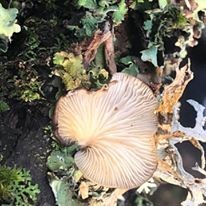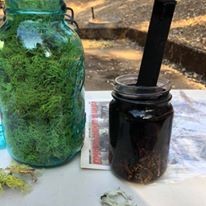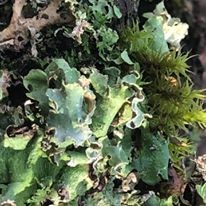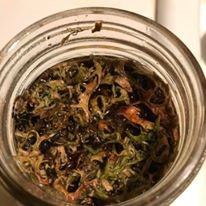I’m Likin’ Lichens
By Cathy Koos
I recently moved from a pine and fir forest home to the oak foothills of rural Sutter Creek. What a change, from the side of a mountain to a creekside. My son is a professional forester working in local timberlands, and sometimes I find a handful of wildflowers, an interesting skull, lichen-covered branches or bags of mushrooms on my porch as early morning gifts from his forest forays.
 (local Sierra foothill lichens, CMKoos 2020)
(local Sierra foothill lichens, CMKoos 2020)
According to Live Science, A lichen, or lichenized fungus, is actually two organisms functioning as a single, stable unit. Lichens comprise a fungus living in a symbiotic relationship with an alga or cyanobacterium (or both in some instances). There are about 17,000 species of lichen worldwide. https://www.livescience.com/55008-lichens.html
In our Sierra mountains, the primary lichen is bright green wolf lichen usually found on the higher elevation fir trees and scattered on the ground below the trees. Letharia vulpina is a fruticose lichenized species of fungus in the family Parmeliaceae. That is probably the most technical information any of us need to know.
 (Left – Wolf lichen; right Staghorn lichen fermenting. CMKoos 2020)
(Left – Wolf lichen; right Staghorn lichen fermenting. CMKoos 2020)
What we do need to know is that this produces a wonderful dye ranging from bright yellow to chartreuse – without any mordant – on silk, cotton and wool. Simmered overnight in a crockpot, this wonderful dye is a promise of spring.
When I moved to the oak-studded foothills, I was truly amazed at the variety of lichens coming off the oak trees. Some windfall branches have 4-5 different species of lichen and even mushrooms.
 (local Sierra foothill lichens, CMKoos 2020)
(local Sierra foothill lichens, CMKoos 2020)
These staghorn-type species give a range of pink to purple dyes but do require laissez faire fermentation in ammonia. The easiest process I have found is to collect the windblown lichens while I am walking my dog, sort them into species and pop them in a quart canning jar.
I have been successful with 1:4 formula of ammonia: water. Cap the jar and let it ferment for a few months. Shake the jar and take the lid off every couple days to agitate and get oxygen into the jar. You will know success when you start to see a pink to purple cast to the liquid.
 (Staghorn lichen fermenting, CMKoos 2020)
(Staghorn lichen fermenting, CMKoos 2020)
Lichens grown on boulders also, but these are fragile and take years to form. Always be sure to only collect lichens laying on the ground; never pick it off the tree or boulders.
It is a grandly capricious experiment with nature. Go forth and have fun!